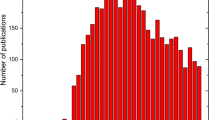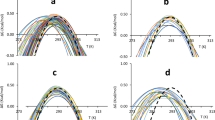Abstract
GdmCl (6 M) unfolded lysozyme was previously shown to refold via kinetically partitioned pathways (Kiefhaber in Proc Natl Acad Sci 92:9029–9033, 1995). About 80% of the unfolded lysozyme molecules refold on a slow pathway with well-populated intermediates. The remaining 20% of denatured lysozyme refold on a fast track without detectable intermediate. This kinetic heterogeneity has been proposed to originate from the collapsed state of lysozyme folding. Using the method of disulfide scrambling, we demonstrate in this report that these two populations of unfolded lysozyme can be isolated and analyzed separately. GdmCl (6 M) denatured lysozyme actually comprises two major populations of unfolded isomers, namely X-LYZ-a and X-LYZ-b with molar ratio of about 80:20. X-LYZ-a and X-LYZ-b exist in equilibrium in the unfolded state. Their disulfide structures and CD properties indicate that X-LYZ-a is more extensively unfolded than X-LYZ-b. Refolding experiments using the method of disulfide scrambling also show that folding kinetics of X-LYZ-a is about 8–10 times slower than that of X-LYZ-b and folding intermediates of X-LYZ-a is far more heterogeneous than that of X-LYZ-b. The results highlight the implication of the conformational heterogeneity of 6 M GdmCl denatured proteins for the interpretation of the initial stage of protein folding mechanism.





Similar content being viewed by others
Abbreviations
- LYZ:
-
Lysozyme
- X-LYZ:
-
Scrambled lysozyme
- α-LA:
-
α-Lactalbumin
- HPLC:
-
High pressure liquid chromatography
References
Bachmann A, Segel D, Kiefhaber T (2002) Biophys Chem 96:141–151
Bai P, Peng Z (2001) J Mol Biol 314:321–329
Baldwin RL (1989) Trends Biochem Sci 14:291–294
Bieri O, Kiefhaber T (2001) J Mol Biol 310:919–935
Chang J-Y (1994) Biochem J 300:643–650
Chang J-Y (1999) J Biol Chem 274:123–128
Chang J-Y (2002) J Biol Chem 277:120–126
Chang J-Y, Ballatore A (2000) FEBS Lett 473:183–187
Chang J-Y, Li L (2001) J Biol Chem 276:9705–9712
Chang J-Y, Li L (2002) FEBS Lett 511:73–78
Chang J-Y, Bulychev A, Li L (2001) FEBS Lett 487:298–300
Daggett V, Fersht AR (2003) Trends Biochem Sci 28:18–25
Gorovits BM, Seale JW, Horowitz PM (1995) Biochemistry 34:13928–13933
Hammack BN, Smith CR, Bowler BE (2001) J Mol Biol 311:1091–1104
Ikeguchi M, Kuwajima K, Mitani M, Sugai S (1986) Biochemistry 25:6965–6972
Kato H, Feng H, Bai Y (2007) J Mol Biol 365:870–880
Kiefhaber T (1995) Proc Natl Acad Sci USA 92:9029–9033
Kuwajima K, Hiraoka Y, Ikeguchi M, Sugai S (1985) Biochemistry 24:874–881
Matagne A, Dobson CM (1998) Cell Mol Life Sci 54:363–371
Matagne A, Radford SE, Dobson CM (1997) J Mol Biol 267:1068–1074
McCarney ER, Kohn JE, Plaxco KW (2005) Crit Rev Biochem Mol Biol 40:181–189
Nakao M, Maki K, Arai M, Koshiba T, Nitta K, Kuwajima K (2005) Biochemistry 44:6685–6692
Nakatani H, Maki K, Saeki K, Aizawa T, Demura M, Kawano K, Tomoda S, Kuwajima K (2007) Biochemistry 46:5238–5251
Neri D, Billeter M, Wider G, Wuthrich K (1992) Science 257:1559–1563
Noyelle K, Joniau M, Van Dael H (2001) J Mol Biol 308:807–819
Parker MJ, Marqusee S (2000) J Mol Biol 300:1361–1375
Radford SE, Dobson CM, Evans PA (1992) Nature 358:302–307
Sasahara K, Nitta K (2006) Proteins 63:127–135
Schlepckow K, Wirmer J, Bachmann A, Kiefhaber T, Schwalbe H (2008) J Mol Biol 378:686–698
Shortle D, Ackerman MS (2001) Science 293:487–489
Shortle D, Abeygunawardana C (1993) Structure 1:121–134
Smith LJ, Fiebig KM, Schwalbe H, Dobson CM (1996) Fold Des 1:R95–R106
Tanford C (1968) Adv Protein Chem 23:121–282
Tanford C (1970) Adv Protein Chem 24:1–95
Wildegger G, Kiefhaber T (1997) J Mol Biol 270:294–304
Yi Q, Scalley-Kim ML, Alm EJ, Baker D (2000) J Mol Biol 299:1341–1351
Acknowledgments
The author acknowledges the support of IsoVax Therapeutic Inc. and the endowment from the Robert Welch foundation.
Author information
Authors and Affiliations
Corresponding author
Rights and permissions
About this article
Cite this article
Chang, JY., Lu, BY. & Li, L. Fast and Slow Tracks in Lysozyme Folding Elucidated by the Technique of Disulfide Scrambling. Protein J 28, 300–304 (2009). https://doi.org/10.1007/s10930-009-9195-y
Published:
Issue Date:
DOI: https://doi.org/10.1007/s10930-009-9195-y




